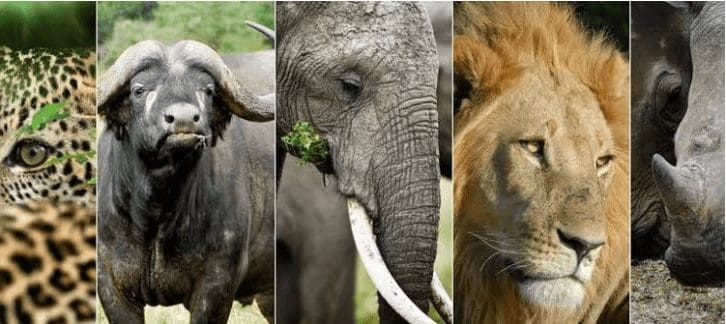The Big Five—lions, elephants, leopards, buffalo, and rhinos—are the most iconic animals to spot on an African safari, and the Masai Mara is one of the best places in the world to see them. Known for their historical difficulty to track, these majestic creatures symbolize the ultimate safari experience. The Masai Mara offers a unique opportunity to observe them in their natural habitat, particularly during the Great Migration. Whether you’re a first-time visitor or a seasoned safari-goer, spotting the Masai Mara big five is an unforgettable adventure.
What Are the Big Five?
The Big Five refers to five of Africa’s most iconic and revered animals: lions, elephants, leopards, buffalo, and rhinos. The term was originally coined by big-game hunters due to the difficulty and danger involved in hunting these animals on foot, rather than because of their size. Each of these animals presents unique challenges when it comes to tracking them in the wild.
- Lions are known for their power and pride dynamics, making them fearsome predators.
- Elephants, the largest land mammals, are intelligent and highly protective of their herds, making them unpredictable.
- Leopards are elusive and solitary, often camouflaging in trees or thick vegetation, which makes them difficult to spot.
- Buffalo are highly aggressive and unpredictable, especially when wounded or threatened, earning them the nickname “Black Death.”
- Rhinos, both black and white species, are critically endangered, and their rarity adds to the difficulty of tracking them in the wild.
While the Big Five originally had roots in hunting, today they symbolize the top wildlife species that safari-goers aim to see, and the Masai Mara is an ideal destination to witness all five in their natural environment.
Lions: Kings of the Masai Mara
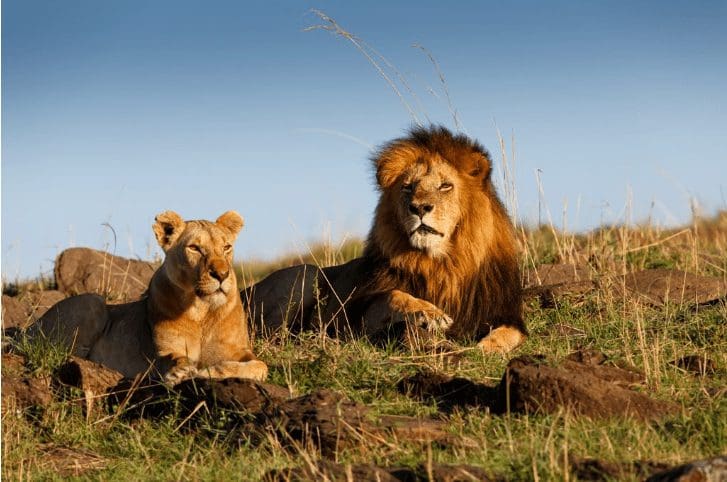
Lions, often called the kings of the Masai Mara, are among the most sought-after wildlife sightings on a safari. Known for their majestic presence and formidable hunting skills, lions play a central role in the Masai Mara’s ecosystem, especially during the Great Migration.
Where to Find Lions in the Masai Mara
During the Great Migration (July to October), lions are particularly active, drawn to the abundance of prey. You can often spot them around Mara River crossings, where they wait for opportunities to hunt weakened or isolated wildebeests and zebras. The Musiara Marsh and the Mara Triangle are also known for their lion prides, making these areas prime spots for lion sightings.
Lion Behavior and Pride Dynamics
Lions are social animals, living in prides that typically consist of related females, their cubs, and a few dominant males. Female lions do most of the hunting, working in coordinated groups to take down larger prey. Males, meanwhile, defend the pride’s territory and can often be seen patrolling their domain. When hunting, lions use stealth and teamwork, ambushing their prey with impressive precision.
Best Times to Spot Lions
Lions are most active during the early mornings and late afternoons, when the temperatures are cooler. Game drives at these times offer the best chance to witness lions on the move, whether they’re hunting, feeding, or resting after a meal. As the day heats up, lions tend to seek shade and become less visible, making morning and evening drives ideal for lion spotting.
In the Masai Mara, seeing lions in their natural environment is not only thrilling but also offers a glimpse into the complex dynamics of one of Africa’s most powerful predators.
Elephants: Gentle Giants of the Savanna
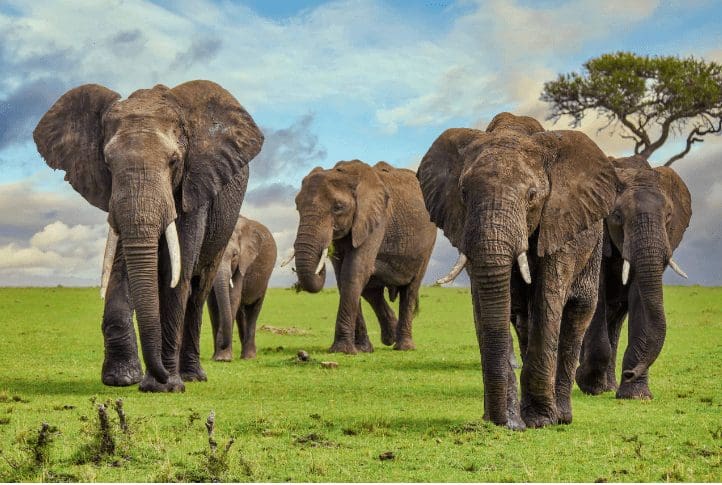
Elephants, the gentle giants of the savanna, are a highlight of any Masai Mara safari. These magnificent creatures are known for their intelligence, strong social bonds, and impressive size, making them one of the most fascinating animals to observe in the wild.
Elephant Herds and Social Structure
Elephants live in herds led by a matriarch, typically the oldest and most experienced female. The herd consists of related females and their offspring, while males usually leave the herd when they reach adolescence and live solitary lives or form smaller bachelor groups.
The strong familial bonds within elephant herds are evident in their behavior; they care for one another, protect the young, and mourn the loss of herd members. This close-knit social structure is part of what makes elephants so compelling to observe.
Elephant Conservation in the Masai Mara
Elephants have faced significant threats due to poaching and habitat loss, but conservation efforts in the Masai Mara have helped protect these majestic creatures. Local and international organizations, along with the Maasai community, have worked tirelessly to reduce human-wildlife conflict and preserve elephant habitats.
Anti-poaching units and conservation programs have made the Masai Mara one of the safer areas for elephants, allowing them to thrive. Visitors can learn more about these efforts during their safari and contribute by choosing eco-friendly tours that support conservation.
Safely Observing Elephants and the Best Viewing Spots
Elephants are generally peaceful animals, but it’s essential to observe them from a safe distance. Your guide will ensure you remain at a respectful distance, especially when viewing breeding herds with young calves or when males are in musth (a heightened hormonal state that can make them more aggressive).
Some of the best places to spot elephants in the Masai Mara include the Mara River and the Sekenani and Talek areas, where herds often gather around water sources. Early morning or late afternoon game drives provide excellent opportunities to watch them socializing, foraging, or bathing in the river.
Watching these gentle giants roam the Masai Mara is an awe-inspiring experience that offers a deeper appreciation for the complex, intelligent, and emotional world of elephants.
Leopards: The Elusive Big Cat
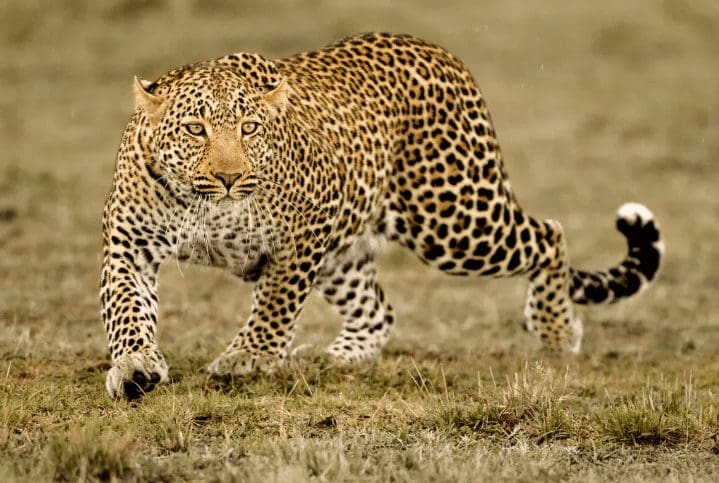
Leopards, known for their elusive nature, are the hardest of the Big Five to spot in the Masai Mara. Their solitary and secretive behavior, coupled with excellent camouflage, allows them to blend seamlessly into their surroundings, making leopard sightings rare and rewarding.
Why Leopards Are Difficult to Spot
Leopards are nocturnal and highly solitary, which makes them difficult to track during daytime safaris. They spend much of their time in trees or dense thickets, resting during the day and becoming more active in the early mornings or late evenings.
Their spotted coats provide excellent camouflage in both the savanna and wooded areas, allowing them to disappear into the landscape. Unlike lions, which hunt in prides and are often out in the open, leopards prefer to stay hidden and hunt alone, contributing to their elusive reputation.
Popular Areas for Leopard Sightings in the Masai Mara
Although challenging to spot, there are several areas in the Masai Mara where leopards are known to frequent:
- Riverbanks: Leopards are often found near rivers like the Talek and Mara Rivers, where they can hunt antelopes and other prey that come to drink.
- Wooded Areas: The dense woodlands along riverbanks or in regions like the Mara Triangle offer leopards the cover they need to remain hidden while stalking prey.
- Acacia Trees: Leopards are strong climbers and can often be found resting or feeding in acacia trees, where they store their kills to avoid scavengers like lions or hyenas.
Tips for Spotting Leopards
To increase your chances of seeing a leopard during your safari, follow these tips:
- Go on early morning or late afternoon drives: Leopards are most active during the cooler parts of the day, making dawn and dusk the best times for spotting them.
- Be patient and observant: Leopard sightings require keen attention. Look for signs like scratch marks on trees or alarm calls from prey animals, which can indicate a leopard’s presence.
- Rely on experienced guides: A knowledgeable guide is essential when searching for leopards. They know the areas where leopards are commonly seen and can interpret the subtle signs of their movements.
While spotting a leopard may take patience and a bit of luck, catching a glimpse of this magnificent predator in the wild is one of the most exciting rewards of a Masai Mara safari.
Buffalo: The Resilient Warriors of the Plains
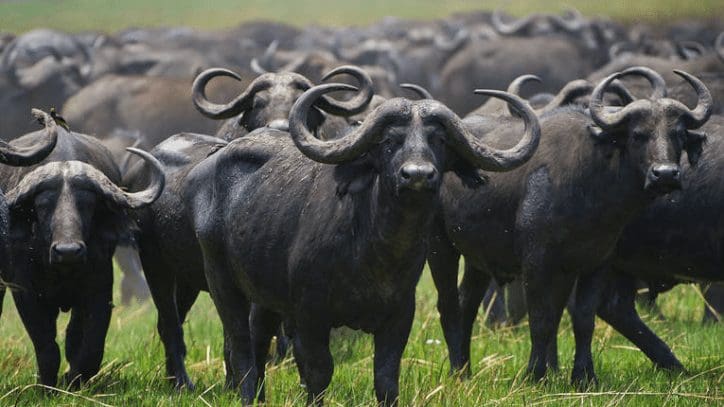
Buffalo, often referred to as the resilient warriors of the plains, are a common but powerful sight in the Masai Mara. Known for their strength and unpredictable nature, these animals play a critical role in the savanna ecosystem.
Behavior and Social Dynamics of Buffalo Herds
Buffalo, or Cape buffalo, are highly social animals that live in large herds, sometimes numbering in the hundreds. Dominant males lead these herds, while younger males often form bachelor groups. Female buffalo and their calves stay in the center of the herd for protection, while the stronger males protect the group from predators like lions.
Buffalo are fiercely protective of one another, and when threatened, they use their size, sharp horns, and collective strength to defend themselves and their young. If one member of the herd is attacked, others often come to its defense, making them formidable opponents.
Buffalo as Formidable Prey and Their Role in the Ecosystem
Despite their size and strength, buffalo are a primary target for large predators, especially lions. However, buffalo do not go down easily. A single buffalo can defend itself with its powerful horns, and in groups, they have been known to charge predators and even rescue members of the herd from attacks. This resilience makes them one of the most dangerous prey animals, often resulting in dramatic and intense predator-prey interactions.
Buffalo also play an important role in the Masai Mara ecosystem. By grazing on large swathes of grass, they help maintain the health of the grasslands, creating open spaces that benefit other herbivores. Additionally, their droppings fertilize the soil, supporting plant growth and the overall biodiversity of the region.
Where to Find Large Buffalo Herds in the Masai Mara
Buffalo are widespread throughout the Masai Mara, and you can often find large herds grazing in the open plains. The Mara Triangle and areas near the Mara River are especially good spots to observe buffalo. Early mornings and late afternoons are the best times for sightings, as the herds tend to rest during the heat of the day. During the dry season, buffalo gather around water sources, making them easier to spot.
Witnessing a herd of buffalo in action offers a powerful reminder of their resilience and significance within the Masai Mara, adding another exciting dimension to your safari experience.
Rhinos: A Conservation Success Story
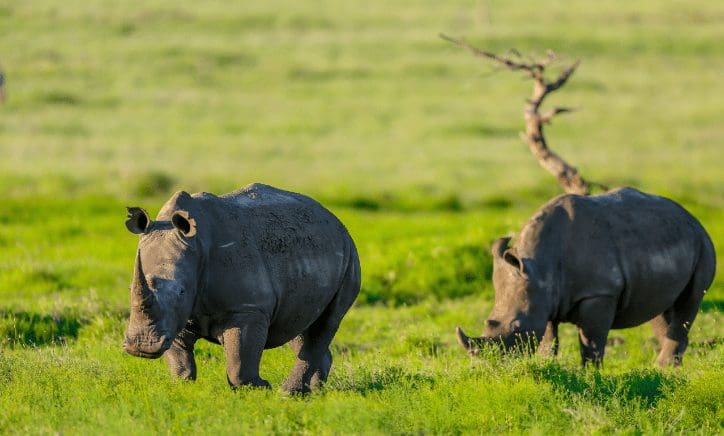
Rhinos are a symbol of resilience and conservation success in the Masai Mara. Once on the brink of extinction due to poaching, these majestic animals have been the focus of significant conservation efforts, ensuring their survival for future generations to witness.
Importance of Rhino Conservation in the Masai Mara
The conservation of rhinos in the Masai Mara is crucial for their survival and maintaining the ecosystem’s balance. Both black rhinos and white rhinos are critically endangered, largely due to illegal poaching for their horns.
The Masai Mara, conservation organizations, and local communities have implemented strict anti-poaching measures and established protected areas where rhinos can roam freely.
Conservation efforts include increased security patrols, collaboration with local Maasai communities, and educational programs to raise awareness about the importance of protecting rhinos.
Differences Between Black and White Rhinos
The Masai Mara is home to the critically endangered black rhino. Though white rhinos are more commonly found in other parts of Kenya, it’s the black rhino that you’ll most likely encounter in this region.
- Black Rhinos: Known for their pointed, hooked upper lip, black rhinos are browsers, feeding on shrubs and bushes. They are more solitary and often found in denser vegetation.
- White Rhinos: Larger and with a square-shaped mouth, white rhinos are grazers, feeding primarily on grass. They are more social and can be seen in groups, though they are less common in the Masai Mara.
Key Areas for Rhino Spotting and Conservation Efforts
The Mara Triangle, a section of the Masai Mara National Reserve, is one of the best places to spot black rhinos. Thanks to dedicated conservation efforts, this region has gradually increased rhino populations.
Anti-poaching patrols, protected area fencing, and rhino monitoring programs have been instrumental in these efforts. Local Maasai communities also play a key role in safeguarding rhinos, working alongside conservationists to prevent illegal poaching and promote eco-tourism as a sustainable alternative.
While rhino sightings are rare and thrilling, the Masai Mara’s conservation success offers hope for these incredible animals’ future. Your safari provides a chance to see these magnificent creatures and supports ongoing efforts to protect them.
Tips for Spotting the Big Five on Your Safari
Spotting the Big Five on your Masai Mara safari is one of the most rewarding experiences, but knowing when and how to maximize your chances can make all the difference.
Best Times for Wildlife Viewing
The ideal times to view wildlife, especially the Big Five, are early morning and late afternoon. These cooler parts of the day are when animals are most active. Lions, leopards, and other predators hunt during these hours, while elephants, buffalo, and rhinos often move toward water sources for drinking. Plan your game drives to start just before sunrise and end just after sunset for the best chances of sightings.
The Role of Experienced Guides
Experienced guides play a crucial role in tracking and spotting the Big Five. Their deep knowledge of animal behavior, the landscape, and specific hotspots in the Masai Mara greatly increases your chances of spotting elusive animals like leopards and rhinos. Guides are also trained to spot subtle signs—such as tracks or alarm calls from prey animals—indicating a predator nearby. Trusting in their expertise will make your safari more successful and enriching as they share insights into the behavior and dynamics of the wildlife you encounter.
Dry Season vs. Rainy Season
The dry season (June to October) is the best time for spotting the Big Five because animals congregate around water sources, making them easier to find. The sparse vegetation also provides clearer views, and predators like lions and leopards are more active as they follow herds of prey. While less ideal for wildlife viewing, the rainy season (March to May) offers lush landscapes and fewer tourists, which can make for a more private and scenic experience. However, tracking animals is more challenging due to dense vegetation, and some areas may be harder to access due to muddy roads.
By timing your game drives well, relying on expert guides, and choosing the right season, your chances of spotting the Big Five in the Masai Mara greatly improve, making your safari a truly memorable adventure.
Other Wildlife to Watch for in the Masai Mara
While the Big Five are the stars of a Masai Mara safari, the reserve is home to a vast array of other spectacular wildlife that makes every game drive an exciting experience. The richness of the Masai Mara ecosystem extends far beyond the Big Five, showcasing Africa’s diverse and thriving wildlife.
Giraffes
The iconic Masai giraffe, with its long neck and graceful stride, is a common sight in the Masai Mara. Giraffes are often spotted feeding on acacia trees, and watching them move elegantly across the plains is a breathtaking experience. Their height allows them to browse for food out of reach of other herbivores, contributing to the ecological balance of the savannah.
Zebras
Zebras, particularly the plains zebra, are abundant in the Masai Mara. They often travel alongside the wildebeests during the Great Migration, creating striking scenes of black-and-white stripes moving across the landscape. Zebras are social animals and are known for their strong herd dynamics, often gathering in large groups to protect themselves from predators.
Cheetahs
The cheetah, the fastest land animal, is another thrilling predator you can see in the Masai Mara. Unlike lions, cheetahs prefer open plains, where they can use their incredible speed to chase down prey like gazelles. While they are not as common as lions, cheetahs are often spotted in the Mara Triangle, making a game drive in this area particularly exciting.
Wildebeests
Known for their part in the Great Migration, wildebeests are a central feature of the Masai Mara. The annual migration brings millions of wildebeests from the Serengeti into the Mara, creating one of the most dramatic wildlife spectacles in the world. Even outside of migration season, wildebeests are commonly seen grazing in the plains, contributing to the dynamic ecosystem of the reserve.
The Richness of the Masai Mara Ecosystem
Beyond the Big Five and these key species, the Masai Mara is teeming with other wildlife, including antelopes, hippos, crocodiles, hyenas, and countless bird species.
The reserve’s biodiversity creates a balanced and thriving ecosystem, where predators and prey coexist in a delicate natural harmony. Whether you’re watching a herd of elephants or catching sight of a cheetah sprinting across the plains, every moment in the Masai Mara reveals the richness of the African wilderness.
The Masai Mara offers a complete wildlife experience, where each species plays a vital role in the ecosystem, ensuring that every safari is full of discovery and excitement.
The Ultimate Big Five Safari Experience Awaits
The Masai Mara is one of the best places on Earth to spot the Big Five—lions, elephants, leopards, buffalo, and rhinos—thanks to its diverse ecosystems and thriving wildlife population. From the dramatic hunts of lions during the Great Migration to the rare sight of a leopard in a tree, the Masai Mara offers an unrivaled safari experience.
At The Mara Wanderlust, we specialize in crafting personalized safaris that ensure you maximize your chances of seeing the Big Five while immersing yourself in the beauty and culture of the Mara. Let us guide you through this once-in-a-lifetime adventure, creating memories that will stay with you forever. Plan your Big Five safari with us for an unforgettable journey into Africa’s wild heart.
FAQs
Can I see all of the Big Five in one safari?
Yes, it’s possible to see all of the Big Five in one safari, especially in the Masai Mara, but it depends on timing and luck. Lions and elephants are frequently spotted, while leopards and rhinos can be more elusive.
How can I increase my chances of seeing leopards in the Masai Mara?
To increase your chances of seeing leopards, go on early morning or late afternoon game drives, when they are most active. Focus on areas near riverbanks and woodlands, and rely on the expertise of your guide for tracking.
Are there any areas in the Masai Mara that are better for certain Big Five animals?
Yes, specific areas are better for certain animals. For example, Mara River is prime for lions and buffalo, while Mara Triangle and wooded riverbanks are ideal for spotting elusive leopards and rhinos.
What time of year is best for seeing the Big Five in the Masai Mara?
The best time to see the Big Five is during the dry season from June to October, coinciding with the Great Migration. Wildlife is easier to spot around water sources, and the clear weather improves visibility during game drives.
Is it safe to see the Big Five up close?
Yes, it’s safe to see the Big Five up close as long as you follow your guide’s instructions and stay inside the vehicle. Guides are trained to maintain a safe distance from the animals, ensuring both your safety and theirs.

